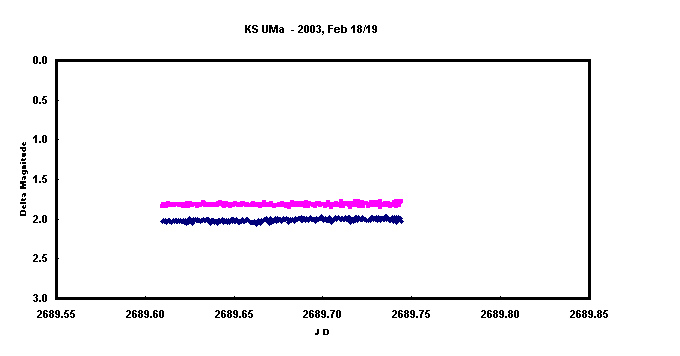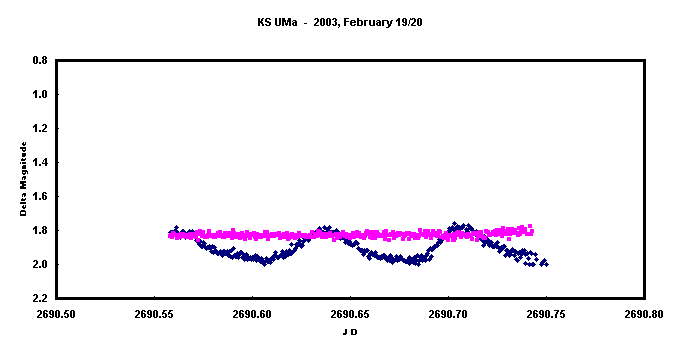The February 2003 outburst of KS UMa
The
February 2003 outburst of KS UMa was first reported
by Belgian variable star observer Eddy Muyllaert on
2003, February 18.840 UT. The night before, the
object definitely was still fainter than mag 14.6
(observation by Gary Poyner).
I started an unfiltered CCD photometry session on
this target, at CBA Belgium Observatory, during the
night of the outburst detection. My session took
place under good atmospheric conditions and lasted
for about 3.4 hours. No obvious modulations are
visible in the resulting light curve (see below),
suggesting that the present outburst is either a
normal outburst or a superoutburst caught in its
very initial development stage.

The
next night (2003, February 19/20) was clear again
over Belgium, and allowed me to monitor the object
for 4.6 hours under good conditions. This time, the
light curve was telling a completely different story
(see below), with strong superhumps being present,
and therefore classifying the present outburst as a
genuine superoutburst. Using the PDM technique, I
derived a superhump period of 0.0719 +/- 0.0010 d.
This Psh value is slightly higher than the value of
0.0697 d that I reported in 1998 (CVC 161, vsnet-alert 1448; CVC 162, vsnet-alert
1450), at the moment I detected the UGSU-type
nature of KS UMa. D. Nogami (vsnet-alert 1452) also
reported a Psh value of 0.069 d.

The
next nights were clear
again, allowing me to continue the photometry
sessions on KS UMa. The resulting light curves are
listed below.
Here's
some interesting notes, extracted from "VSNET
Weekly Campaign Summary" (vsnet-campaign 1372)
regarding the KS UMa superoutburst :
"As reported by E. Muyllaert and G.
Poyner on Feb. 18, the SU
UMa-type
dwarf nova, KS UMa is now in outburst (12.7,
12.9mag;vsnet-campaign-dn 3447). There was no clear
modulations in the light curve
obtained by T. Vanmunster on Feb. 18/19 (vsnet-campaign-dn
3449). A subsequent observation by K. Nakajima
showed a weak (~0.05 mag) signal,
which may be attributed to early-stage
superhumps (vsnet-campaign-dn 3454). T. Vanmunster
then detected clear superhumps
with an amplitude of 0.21 mag on February 19/20
(vsnet-campaign-dn 3455, 3459). Using the combined
data, T. Kato reported that
the superhump period of the early superoutburst
phase was 0.07068(7) d, which is substantially
longer than the previously
reported periods (vsnet-campaign-dn 3460). On
Feb. 22, T. Kato reported that,
although there was a slight tendency of
a period decrease during this period, no striking
period change as recorded in
UV Gem was observed (vsnet-campaign-dn 3464).
A. Olech et al., the Ostrowik team, performed
time-series observation on
Feb. 21/22 and 22/24 and reported a period of 0.0699
+/- 0.0002 days (vsnet-campaign-dn
3465, 3476). T. Kato revised the superhump
period to be 0.07026(2) d on Feb. 23. The rate of
period change dot(P)/P was
around -3*10(^4). While the baseline was still
short, if confirmed, this negative
period derivative is one of the most
pronounced among moderate-period SU UMa-type dwarf
novae (vsnet-campaign-dn
3467). In the late Feb. 23 - early Feb. 24 data,
the main superhump maxima became
weaker, while other peaks became stronger.
The profile then become very complex, which
resembles that of superhumps
during the rapid decline stage. However, the present
stage is too early for such a rapid decline, neither
observations show such a rapid trend
(vsnet-campaign-dn 3484). The
superoutburst is now ongoing (vsnet-campaign-dn
3448, 3453, 3456, 3463,
3479)."